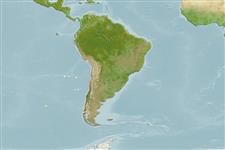Common names from other countries
Environment: milieu / climate zone / depth range / distribution range
Ecologie
; diepteverspreiding 0 - 20 m (Ref. 101272). Temperate, preferred 18°C (Ref. 107945); 16°S - 47°S, 110°W - 70°W
Southeast Pacific: Chile, Easter Island, and Peru. Subtropical to temperate.
Length at first maturity / Size / Gewicht / Leeftijd
Maturity: Lm ? range ? - ? cm Max length : 8.0 cm SHL mannelijk/geslacht niet bekend; (Ref. 101426)
Common shell length is between 5 to 7 cm (Ref. 101426).
Life cycle and mating behavior
Geslachtsrijpheid | Voortplanting | Kuitschieten | Eieren | Fecundity | Larven
Members of the class Bivalvia are mostly gonochoric, some are protandric hermaphrodites. Life cycle: Embryos develop into free-swimming trocophore larvae, succeeded by the bivalve veliger, resembling a miniature clam.
Urban, H.J. and B. Campos. 1994. (Ref. 75339)
Status op de Rode Lijst van het IUCN (Ref. 130435: Version 2024-1)
Status bij CITES (Ref. 108899)
Not Evaluated
Not Evaluated
Gebruik door de mens
Visserij: commercieel
FAO - Visserij: landings, soortsprofiel | FishSource | Sea Around Us
Tools
Internet-bronnen
Estimates based on models
Weerstandsvermogen
Gemiddeld, minimale populatieverdubbelingstijd 1,4-4,4 jaar (K=0.17-0.25).
Kwetsbaarheid
Low to moderate vulnerability (35 of 100).
